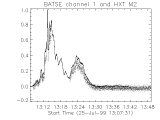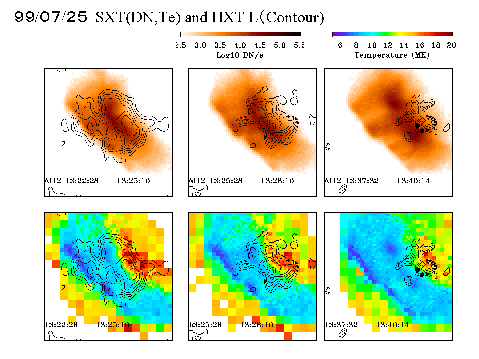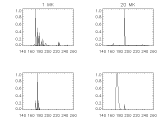
The flare involved the whole panoply of phenomena, ranging from hard X-rays to meter waves, plus eruption and a CME. It was well-observed by Compton GRO as well as by TRACE and by Yohkoh. Here is a glance at the hard X-ray light curves:

This shows both the BATSE low channel (nominally 25-50 keV, and quite free of "thermal contamination", and the Yohkoh/HXT M2 channel, 33-53 keV. The plot shows the data gap that Yohkoh suffered due to a telemetry reading, but they do sample the interesting parts of the rise phase well, including the gradual increase at about 13:24 UT.
There has been no time to prepare images, but the TRACE data are very complete in Lyman-alpha. Since the flare is seen off the limb, the experts think that the main response is in this line, rather than in adjacent continuum These data show many of the expected phenomena - eruption, flare footpoints, arcades with downward-streaming "coronal rain." Even more exciting than this, the TRACE 171 and 195 EUV channels both show hot response that can be attributed to radiation sources not in the nominal passbands. These hot sources - probably continuum in the 171 channel, and FeXXIV in the 195 channel - occur near in time to the impulsive phase (see the figure above to define it) and represent the hottest, newest, most extreme corona.
An empirical overlay showing HXT contours for three time intervals with (upper) SXT intensity maps, and (lower) SXT filter-ratio temperatures:

Because the coalignment is empirical, the interpretation is not perhaps so straightforward. However the HXT L band, nominally 15-23 keV, actually has substantial response to thermal sources in the 15-20 MK temperature range. So does SXT, and so does TRACE (see below). So we believe that we have an excellent opportunity here distinguish the hot, "superhot", and non-thermal sources.
The first flare comprehensively observed at Lyman-alpha, and with good spatial resolution, has produced an array of expectable and unexpected observations. We are very fortunate to be among the first to view these data and to try to draw conclusions, but of course some painstaking work must precede the sweeping generalizations we'd like to make! In this section we just suggest some directions for future research.
For the continuum in the 171 channel, it's even more exciting, because in either this flare or some other flare we may be able to image the "superhot" component (> 30 MK) with TRACE's exquisitely small 0.5" pixels. We show this possibility in the figure below:

H. Hudson (hudson@isass1.solar.isas.ac.jp)
J. Sato (sato@nro.nao.ac.jp)
July 30, 1999